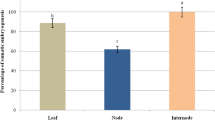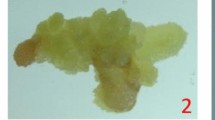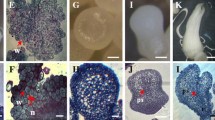Abstract
In this study, we focused on describing and characterizing the somatic embryogenesis (SE) process of Guadua chacoensis through morphohistological and biochemical analysis. For that, G. chacoensis in vitro shoots was used as explant in the induction experiments and we evaluated different Picloram concentrations (0–700 μM), explant pretreatments (constant dark/etiolation or light photoperiod), and explant position (basal, middle, and top region of the shoot). The use of 400 μM of Picloram and the basal region showed the best response for callus induction in dark- (87.5%) and light-pretreated explants (55%). During callus multiplication, we could identify the formation of embryogenic cultures (EC) and non-embryogenic cultures (NEC), which were morphologically characterized as compact and nodular, and friable and soft, respectively. As expected, only the EC were able to maturate when transferred to a Picloram-free culture medium. Biochemical characterization revealed a higher content of spermidine, arginine, methionine, maltose, and mannose in EC, highlighting their involvement with embryogenic competence in this species. In addition, we present a detailed description of the morphohistological events from callus formation until embryo maturation. Taking together, our study firstly reports a SE protocol for G. chacoensis and represents important progress for bamboo SE investigation. Our results shed light on the possibility of the SE application in bamboo species for mass propagation and in vitro conservation.
Key message
Induction of SE in Guadua chacoensis was strongly promoted by using etiolated explants from the basal region of shoots and Picloram, and their embryogenic competence was related to higher endogenous content of several polyamines, amino acids, and carbohydrates.
AbstractSection Graphical abstract










Similar content being viewed by others
References
Arya S, Satsangi R, Arya ID (2008) Large scale plant propagation of edible bamboo Dendrocalamus asper through somatic embryogenesis. J Am Bamb Soc 21:21–31
Blanc G, Lardet L, Martin A, Jacob JL, Carron MP (2002) Differential carbohydrate metabolism conducts morphogenesis in embryogenic callus of Hevea brasiliensis (Mull. Arg.). J Exp Bot 53(373):1453–1462
Borji M, Bouamama-Gzara B, Chibani F, Teyssier C, Ammar AB, Mliki A, Zekri S, Ghorbel A (2018) Micromorphology, structural and ultrastructural changes during somatic embryogenesis of a Tunisian oat variety (Avena sativa L. var ‘Meliane’). Plant Cell Tissue Organ Cult 132(2):329–342. https://doi.org/10.1007/s11240-017-1333-1
Cangahuala-Inocente GC, Silveira V, Caprestano CA, Floh EI, Guerra MP (2013) Dynamics of physiological and biochemical changes during somatic embryogenesis of Acca sellowiana. In Vitro Cell Dev Biol Plant 50(2):166–175. https://doi.org/10.1007/s11627-013-9563-3
Ceasar SA, Ignacimuthu S (2010) Effects of cytokinins, carbohydrates and amino acids on induction and maturation of somatic embryos in Kodo millet (Paspalum scorbiculatum Linn.). Plant Cell Tissue Organ Cult 102(2):153–162. https://doi.org/10.1007/s11240-010-9716-6
de Araújo Silva-Cardoso IM, Meira FS, Gomes AC, Scherwinski-Pereira JE (2019) Histology, histochemistry and ultrastructure of pre-embryogenic cells determined for direct somatic embryogenesis in the palm tree Syagrus oleracea. Physiol Plant 168(4):845–875. https://doi.org/10.1111/ppl.13026
de Carvalho Siva R, Luis ZG, Scherwinski-Pereira JE (2014) The histodifferentiation events involved during the acquisition and development of somatic embryogenesis in oil palm (Elaeis guineensis Jacq.). Plant Growth Regul 72(1):67–80. https://doi.org/10.1007/s10725-013-9837-0
Delporte F, Pretova A, Du Jardin P, Watillon B (2014) Morpho-histology and genotype dependence of in vitro morphogenesis in mature embryo cultures of wheat. Protoplasma 251(6):1455–1470. https://doi.org/10.1007/s00709-014-0647-7
El Hassan AAE, Debergh P (1987) Embryogenesis and plantlet development in the bamboo Phyllostachys viridis (Young) McClure. Plant Cell Tissue Organ Cult 10:73–77. https://doi.org/10.1007/BF00037499
Fehér A (2019) Callus, dedifferentiation, totipotency, somatic embryogenesis: what these terms mean in the era of molecular plant biology? Front Plant Sci 10:536. https://doi.org/10.3389/fpls.2019.00536
Fraga HPF, Vieira LN, Puttkammer CC, da Silva JM, dos Anjos KG, Oliveira EM, Guerra MP (2016) High-efficiency cryopreservation of Araucaria angustifolia (Bertol.) Kuntze embryogenic cultures: ultrastructural characterization and morpho-physiological features. Plant Cell Tissue Organ Cult 124:307–318. https://doi.org/10.1007/s11240-015-0895-z
Godbole S, Sood A, Thakur R, Sharma M, Ahuja PS (2002) Somatic embryogenesis and its conversion into plantlets in a multipurpose bamboo, Dendrocalamus hamiltonii Nees et Arn. Ex Munro. Curr Sci 83:885–889
Godbole S, Sood A, Sharma M, Nagar PK, Ahuja PS (2004) Starch deposition and amylase accumulation during somatic embryogenesis in bamboo (Dendrocalamus asper). J Plant Physiol 161:245–248. https://doi.org/10.1078/0176-1617-01219
Grzyb M, Kalandyk A, Waligórski P, Mikuła A (2017) The content of endogenous hormones and sugars in the process of early somatic embryogenesis in the tree fern Cyathea delgadii Sternb. Plant Cell Tissue Organ Cult 129(3):387–397. https://doi.org/10.1007/s11240-017-1185-8
Hildebrandt TM, Nesi AN, Araújo WL, Braun HP (2015) Amino acid catabolism in plants. Mol Plant 8(11):1563–1579. https://doi.org/10.1016/j.molp.2015.09.005
Jiménez VM (2001) Regulation of in vitro somatic embryogenesis with emphasis on to the role of endogenous hormones. Rev Bras Fisiol Veg 13(2):196–223. https://doi.org/10.1590/S0103-31312001000200008
Jullien F, Van Tran Thanh K (1994) Micropropagation and embryoid formation from young leaves of Bambusa glaucescens ‘golden goddess.’ Plant Sci 98(2):199–207. https://doi.org/10.1016/0168-9452(94)90010-8
Komatsu YH, Piotto KDB, Brondani GE, Gonçalves AN, Almeid M (2011) In vitro morphogenic response of leaf sheath of Phyllostachys bambusoides. J for Res 22(2):209–215. https://doi.org/10.1007/s11676-011-0152-1
Kong EY, Biddle J, Foale M, Adkins SW (2020) Cell suspension culture: a potential in vitro culture method for clonal propagation of coconut plantlets via somatic embryogenesis. Ind Crop Prod 147:112125. https://doi.org/10.1016/j.indcrop.2020.112125
Lipavská H, Konrádová H (2004) Invited review: somatic embryogenesis in conifers: the role of carbohydrate metabolism. In Vitro Cell Dev Biol Plant 40:23–30. https://doi.org/10.1079/IVP2003482
Llebrés MT, Pascual MB, Debille S, Trontin JF, Harvengt L, Avila C, Cánovas FM (2018) The role of arginine metabolic pathway during embryogenesis and germination in maritime pine (Pinus pinaster Ait.). Tree Physiol 38(3):471–484. https://doi.org/10.1093/treephys/tpx133
Londoño X, Peterson PM (1992) Guadua chacoensis (Poaceae: Bambuseae), its taxonomic identity, morphology, and affinities. Novon (St Louis) 2:41–47
Maadon SN, Rohani ER, Ismail I, Baharum SN, Normah MN (2016) Somatic embryogenesis and metabolic differences between embryogenic and non-embryogenic structures in mangosteen. Plant Cell Tissue Organ Cult 127(2):443–459. https://doi.org/10.1007/s11240-016-1068-4
Manokari M, Mehta SR, Priyadharshini S, Badhepuri M, Jayaprakash K, Cokul RM, Shekhawat MS (2021) Histochemical basis of the distinct anatomical features and characterization of primary and secondary metabolites during somatic embryogenesis in Santalum album L. Trees. https://doi.org/10.1007/s00468-021-02199-4
Marulanda M, Gutiérrez L, Márquez M (2005) Micropropagación de Guadua angustifolia Kunt. Rev Col Biotec Veg 87(27):5–15
Mehta R, Sharma V, Sood A, Sharma M, Sharma RK (2011) Induction of somatic embryogenesis and analysis of genetic fidelity of in vitro-derived plantlets of Bambusa nutans Wall., using AFLP markers. Eur J for Res 130(5):729–736. https://doi.org/10.1007/s10342-010-0462-4
Méndez-Hernández HA, Ledezma-Rodríguez M, Avilez-Montalvo RN, Juárez-Gómez YL, Skeete A, Avilez-Montalvo J, De-la-Peña C, Loyola-Vargas VM (2019) Signaling overview of plant somatic embryogenesis. Front Plant Sci 10:77. https://doi.org/10.3389/fpls.2019.00077
Mikuła A, Pożoga M, Grzyb M, Rybczyński JJ (2015) An unique system of somatic embryogenesis in the tree fern Cyathea delgadii Sternb.: the importance of explant type, and physical and chemical factors. Plant Cell Tissue Organ Cult 123(3):467–478. https://doi.org/10.1007/s11240-015-0850-z
Morel G, Wetmore RH (1951) Tissue culture of monocotyledons. Am J Bot 38:138. https://doi.org/10.1002/j.1537-2197.1951.tb14803.x
Murashige T, Skoog F (1962) A revised medium for rapid growth and bio assays with Tobacco tissue cultures. Physiol Plant 15:474–497. https://doi.org/10.1111/j.1399-3054.1962.tb08052.x
Mustafavi SH, Badi HN, Sękara A, Mehrafarin A, Janda T, Ghorbanpour M, Rafiee H (2018) Polyamines and their possible mechanisms involved in plant physiological processes and elicitation of secondary metabolites. Acta Physiol Plant 40(6):1–19. https://doi.org/10.1007/s11738-018-2671-2
Nascimento-Gavioli MCA, Cangahuala-Inocente GC, Steinmacher D, Ree JF, Steiner N, Guerra MP (2017) Physiological and biochemical features of embryogenic and non-embryogenic peach palm (Bactris gasipaes Kunth) cultures. In Vitro Cell Dev Biol Plant 53(1):33–40. https://doi.org/10.1007/s11627-017-9805-x
Navarro BV, Elbl P, De Souza AP, Jardim V, de Oliveira LF, Macedo AF, dos Santos ALW, Buckeridge MS, Floh EI (2017) Carbohydrate-mediated responses during zygotic and early somatic embryogenesis in the endangered conifer, Araucaria angustifolia. PLoS ONE 12(7):e0180051. https://doi.org/10.1371/journal.pone.0180051
Nic-Can GI, Avilez-Montalvo JR, Aviles-Montalvo RN, Márquez-López R, Mellado-Mojica E, Galaz-Ávalos RM, Loyola-Vargas VM (2016) The relationship between stress and somatic embryogenesis. In: Loyola-Vargas VM, Ochoa-Alejo N (eds) Somatic embryogenesis: fundamental aspects and applications. Springer, Cham, pp 151–170. https://doi.org/10.1007/978-3-319-33705-0_9
Nieves N, Segura-Nieto M, Blanco MA, Sánchez M, González A, González JL, Castillo R (2003) Biochemical characterization of embryogenic and non-embryogenic calluses of sugarcane. In Vitro Cell Dev Biol Plant 39(3):343–345. https://doi.org/10.1079/IVP2002391
Nieves N, Sagarra F, González R, Lezcano Y, Cid M, Blanco MA, Castillo R (2008) Effect of exogenous arginine on sugarcane (Saccharum sp.) somatic embryogenesis, free polyamines and the contents of the soluble proteins and proline. Plant Cell Tissue Organ Cult 95(3):313–320. https://doi.org/10.1007/s11240-008-9445-2
Noceda C, Salaj T, Pérez M, Viejo M, Cañal MJ, Salaj J, Rodriguez R (2009) DNA demethylation and decrease on free polyamines is associated with the embryogenic capacity of Pinus nigra Arn. cell culture. Trees 23(6):1285. https://doi.org/10.1007/s00468-009-0370-8
O’Brien TP, McCully ME (1981) The study of plant structure principles and selected methods. Termarcarphi Pty, Melbourne
O’Brien TP, Feder N, McCully ME (1964) Polychromatic staining of plant cell walls by toluidine blue O. Protoplasma 59:368–373. https://doi.org/10.1007/BF01248568
Ogita S (2005) Callus and cell suspension culture of bamboo plant, Phyllostachys nigra. Plant Biotechnol 22(2):119–125. https://doi.org/10.5511/plantbiotechnology.22.119
Ornellas TS, Marchetti CK, Oliveira GHD, Fritsche Y, Guerra MP (2019) Micropropagation of Guadua chacoensis (Rojas) Londoño & PM Peterson. Pesqui Agropecu Trop. https://doi.org/10.1590/1983-40632019v4955450
Pais MS (2019) Somatic embryogenesis induction in woody species: the future after OMICs data assessment. Front Plant Sci 10:240. https://doi.org/10.3389/fpls.2019.00240
Pescador R, Kerbauy GB, Kraus JE, de Melo FW, Guerra MP, Rita de Cássia L (2008) Changes in soluble carbohydrates and starch amounts during somatic and zygotic embryogenesis of Acca sellowiana (Myrtaceae). In Vitro Cell Dev Biol Plant 44(4):289. https://doi.org/10.1007/s11627-008-9118-1
Polesi LG, Fraga HPF, Vieira LN, Heringer AS, dos Santos HP, Guerra MP, Pescador R (2019) Chloroplast ultrastructure and hormone endogenous levels are differently affected under light and dark conditions during in vitro culture of Guadua chacoensis (Rojas) Londoño & P. M. Peterson. Acta Physiol Plant 41:10. https://doi.org/10.1007/s11738-018-2804-7
Polesi LG, Vieira LN, Guerra MP, Fraga HPF (2021) Somatic embryogenesis in bamboos: advances and prospects. In: Ahmad Z, Ding Y, Shahzad A (eds) Biotechnological advances in bamboo: the “green gold” of the earth. Springer, Singapore, pp 85–105
Rakesh B, Sudheer WN, Nagella P (2021) Role of polyamines in plant tissue culture: an overview. Plant Cell Tissue Organ Cult 145:487–506. https://doi.org/10.1007/s11240-021-02029-y
Rao IU, Rao IR, Narang V (1985) Somatic embryogenesis and regeneration of plants in the bamboo Dendrocalamus strictus. Plant Cell Rep 4(4):191–194. https://doi.org/10.1007/BF00269286
R Core Team (2018) R version 3.5.0. R: a language and environment for statistical computing. R Foundation for Statistical Computing, Vienna
Ree JF, Polesi LG, Back F, Bertolazi AA, Silveira V, Guerra MP (2020) Aging peach palm (Bactris gasipaes Kunth) cultures lose embryogenic potential and metabolic cellular function due to continuous culture in hypoxic environments. Plant Cell Tissue Organ Cult 140(1):49–67. https://doi.org/10.1007/s11240-019-01710-7
Reynolds ES (1963) The use of lead citrate at high pH as an electron-opaque stain in electron microscopy. J Cell Biol 17:208–212
Sandhu M, Wani SH, Jiménez VM (2018) In vitro propagation of bamboo species through axillary shoot proliferation: a review. Plant Cell Tissue Organ Cult 132(1):27–53. https://doi.org/10.1007/s11240-017-1325-1
Santa-Catarina C, Silveira V, Balbuena TS, Viana AM, Estelita MEM, Handro W, Floh EIS (2006) IAA, ABA, polyamines and free amino acids associated with zygotic embryo development of Ocotea catharinensis. Plant Growth Regul 49(2):237–247. https://doi.org/10.1007/s10725-006-9129-z
Santa-Catarina C, Silveira V, Scherer GF, Floh EIS (2007) Polyamine and nitric oxide levels relate with morphogenetic evolution in somatic embryogenesis of Ocotea catharinensis. Plant Cell Tissue Organ Cult 90(1):93–101. https://doi.org/10.1007/s11240-007-9259-7
Santos M, Claparols I, Torné JM (1993) Effect of exogenous arginine, ornithine, methionine and γ-amino butyric acid on maize (Zea mays L.) embryogenesis, and polyamine content. J Plant Physiol 142(1):74–80. https://doi.org/10.1016/S0176-1617(11)80110-0
Saxena S, Dhawan V (1999) Regeneration and large-scale propagation of bamboo (Dendrocalamus strictus Nees) through somatic embryogenesis. Plant Cell Rep 18:438–443. https://doi.org/10.1007/s002990050600
Scherwinski-Pereira JE, da Guedes RS, Fermino PCP, Silva TL, Costa FHS (2010) Somatic embryogenesis and plant regeneration in oil palm using the thin cell layer technique. In Vitro Cell Dev Biol Plant 46(4):378–385. https://doi.org/10.1007/s11627-010-9279-6
Sghaier B, Kriaa W, Bahloul M, Novo JVJ, Drira N (2009) Effect of ABA, arginine and sucrose on protein content of date palm somatic embryos. Sci Hortic 120(3):379–385. https://doi.org/10.1016/j.scienta.2008.11.035
Shoeb F, Yadav JS, Bajaj S, Rajam MV (2001) Polyamines as biomarkers for plant regeneration capacity: improvement of regeneration by modulation of polyamine metabolism in different genotypes of indica rice. Plant Sci 160(6):1229–1235. https://doi.org/10.1016/S0168-9452(01)00375-2
Silveira V, Floh EIS, Handro W, Guerra MP (2004) Effect of plant growth regulators on the cellular growth and levels of intracellular protein, starch and polyamines in suspension cultures of Pinus taeda. Plant Cell Tissue Organ Cult 76:53–60. https://doi.org/10.1023/A:1025847515435
Silveira V, de Vita AM, Macedo AF, Dias MFR, Floh EIS, Santa-Catarina C (2013) Morphological and polyamine content changes in embryogenic and non-embryogenic callus of sugarcane. Plant Cell Tissue Organ Cult 114(3):351–364. https://doi.org/10.1007/s11240-013-0330-2
Steiner N, Vieira FDN, Maldonado S, Guerra MP (2005) Effect of carbon source on morphology and histodifferentiation of Araucaria angustifolia embryogenic cultures. Braz Arch Biol Technol 48(6):895–903. https://doi.org/10.1590/S1516-89132005000800005
Steiner N, Santa-Catarina C, Silveira V, Floh EI, Guerra MP (2007) Polyamine effects on growth and endogenous hormones levels in Araucaria angustifolia embryogenic cultures. Plant Cell Tissue Organ Cult 89:55–62. https://doi.org/10.1007/s11240-007-9216-5
Steinmacher DA, Krohn NG, Dantas ACM, Stefenon VM, Clement CR, Guerra MP (2007) Somatic embryogenesis in peach palm using the thin cell layer technique: induction, morpho-histological aspects and AFLP analysis of somaclonal variation. Ann Bot 100(4):699–709. https://doi.org/10.1093/aob/mcm153
Tsay HS, Yeh CC, Hsu JY (1990) Embryogenesis and plant regeneration from another culture of bamboo (Sinocalamus latiflora (Munro) McClure). Plant Cell Rep 9:349–351. https://doi.org/10.1007/BF00232396
Van KTT (2003) Thin cell layer concept. In: Nhut DT et al (eds) Thin cell layer culture system: regeneration and transformation applications. Springer, Dordrecht, pp 1–16. https://doi.org/10.1007/978-94-017-3522-3_1
Venkatachalam P, Kalaiarasi K (2016) Indirect somatic embryogenesis and plantlet development from mature seed embryo explants of Bambusa arundinacea (Retz.) wild. In: Anis M, Ahmad N (eds) Plant tissue culture: propagation, conservation and crop improvement. Springer, Singapore, pp 509–519. https://doi.org/10.1007/978-981-10-1917-3_22
Winter G, Todd CD, Trovato M, Forlani G, Funck D (2015) Physiological implications of arginine metabolism in plants. Front Plant Sci 6:534. https://doi.org/10.3389/fpls.2015.00534
Wójcik AM, Wójcikowska B, Gaj MD (2020) Current perspectives on the auxin-mediated genetic network that controls the induction of somatic embryogenesis in plants. Int J Mol Sci 21(4):1333. https://doi.org/10.3390/ijms21041333
Yeh ML, Chang WC (1986) Plant regeneration through somatic embryogenesis in callus culture of green bamboo (Bambusa oldhamii Munro). Theor Appl Genet 73:161–163. https://doi.org/10.1007/BF00289269
Zhang N, Fang W, Shi Y, Liu Q, Yang H, Gui R, Lin X (2010) Somatic embryogenesis and organogenesis in Dendrocalamus hamiltonii. Plant Cell Tissue Organ Cult 103(3):325–332. https://doi.org/10.1007/s11240-010-9783-8
Acknowledgements
LGP is grateful to Fundação de Amparo à Pesquisa e Inovação do Estado de Santa Catarina (FAPESC) and Coordenação de Aperfeiçoamento de Pessoal de Nível Superior (CAPES) for the doctoral scholarship. The authors also thanks to Central Laboratory of Electron Microscopy (LCME) of the Federal University of Santa Catarina, Brazil.
Funding
This work was supported by Conselho Nacional de Desenvolvimento Científico e Tecnológico (CNPq 302798/2018-8, and CNPq 407974/2018-0).
Author information
Authors and Affiliations
Contributions
LGP performed all experiments and wrote the first draft of the manuscript. LGP, HPFF, and MPG designed the experiments. LGP and DG performed in vitro experiments. LGP, DG, and FB performed biochemical characterization. LGP and EMO performed the electron microscopy analysis. LGP, HPFF, MPG, and NS contributed to data analysis. MPG and HPFF supervised this study. All authors revised the manuscript and approved the submission.
Corresponding author
Ethics declarations
Conflict of interest
The authors declare that they have no conflict of interest.
Additional information
Communicated by Mohammad Faisal.
Publisher's Note
Springer Nature remains neutral with regard to jurisdictional claims in published maps and institutional affiliations.
Rights and permissions
About this article
Cite this article
Giacomolli Polesi, L., Pacheco de Freitas Fraga, H., Goeten, D. et al. Morphohistological and biochemical features of the Guadua chacoensis (Bambusoideae; Poaceae) somatic embryogenesis. Plant Cell Tiss Organ Cult 148, 479–499 (2022). https://doi.org/10.1007/s11240-021-02199-9
Received:
Accepted:
Published:
Issue Date:
DOI: https://doi.org/10.1007/s11240-021-02199-9




